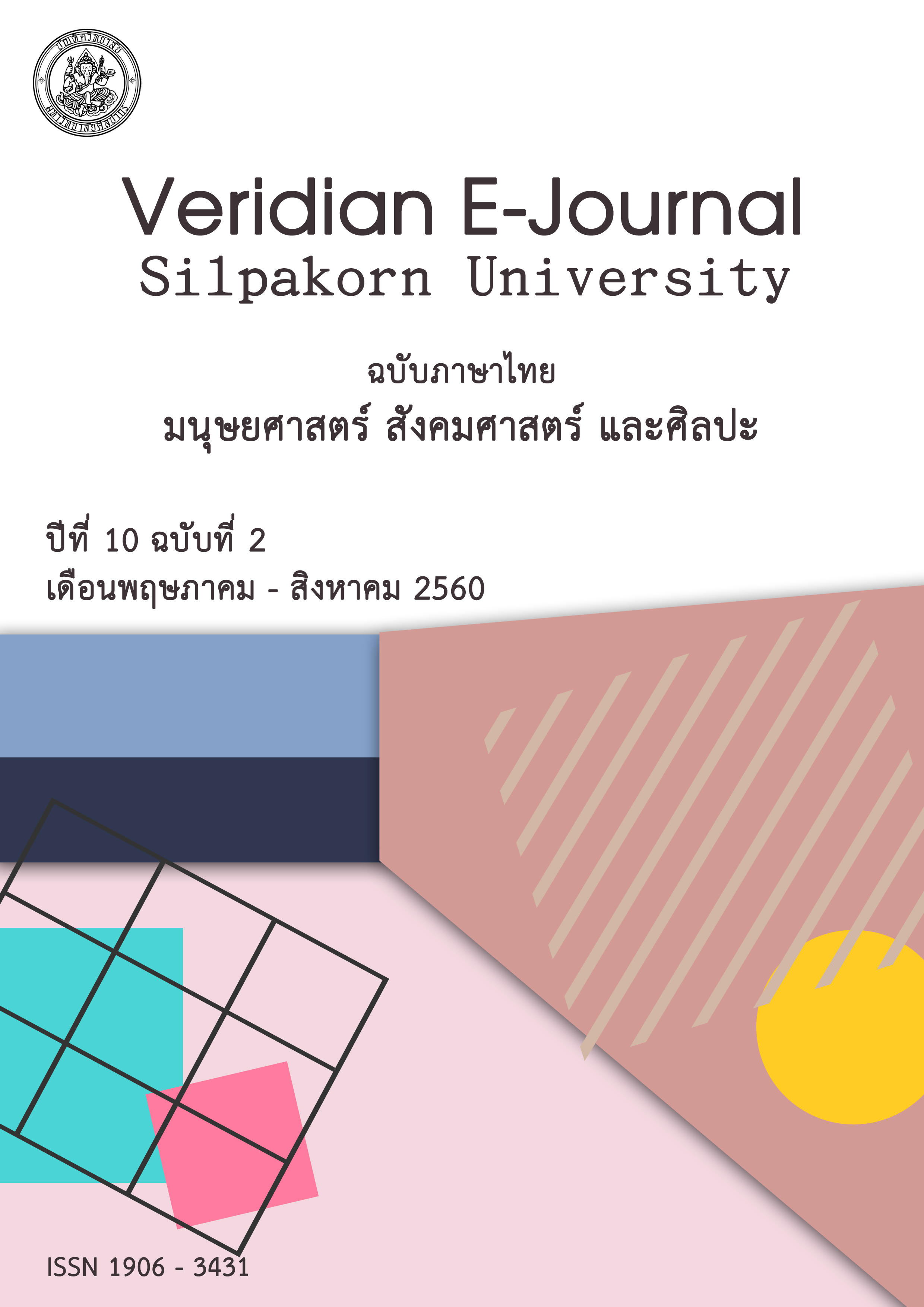นวัตกรรมการพัฒนาทักษะการใช้ภาษาอังกฤษสำหรับผู้บริหารโรงเรียนมัธยมศึกษา
Main Article Content
Abstract
การวิจัยครั้งนี้มีวัตถุประสงค์เพื่อ 1. ทราบประเภทของนวัตกรรมการพัฒนาทักษะการใช้ภาษาอังกฤษสำหรับผู้บริหารโรงเรียนมัธยมศึกษา 2. ทราบนวัตกรรมการพัฒนาทักษะการใช้ภาษาอังกฤษสำหรับผู้บริหารโรงเรียนมัธยมศึกษาที่เหมาะสมตามความคิดเห็นของผู้อำนวยการและรองผู้อำนวยการโรงเรียนมัธยมศึกษา กลุ่มตัวอย่างประกอบด้วย โรงเรียนมัธยมศึกษา สังกัดสำนักงานเขตพื้นที่การศึกษามัธยมศึกษา จำนวน 100 โรงเรียน ผู้ให้ข้อมูลในแต่ละโรงเรียนประกอบด้วย ผู้อำนวยการ 1 คน และรองผู้อำนวยการ 4 คน รวมผู้ให้ข้อมูลทั้งสิ้น 500 คน เครื่องมือที่ใช้ในการวิจัยครั้งนี้ ได้แก่ แบบสัมภาษณ์แบบกึ่งโครงสร้าง และแบบสอบถามความคิดเห็น สถิติที่ใช้ในการวิเคราะห์ข้อมูล ได้แก่ ความถี่, ร้อยละ, การทดสอบไค-สแควร์ และสัมประสิทธิ์สหสัมพันธ์แบบเคนดอลล์
ผลการวิจัยพบว่า
1. นวัตกรรมการพัฒนาทักษะการใช้ภาษาอังกฤษสำหรับผู้บริหารโรงเรียนมัธยมศึกษามี 30 นวัตกรรมแบ่งออกเป็น 2 ประเภท คือ 1) ทำได้ด้วยตนเอง และ2) ทำร่วมกับผู้อื่น สถาบันหรือหน่วยงานอื่น
2. การวิเคราะห์นวัตกรรมการพัฒนาทักษะการใช้ภาษาอังกฤษสำหรับผู้บริหารโรงเรียนมัธยมศึกษาที่เหมาะสมตามความคิดเห็นของผู้อำนวยการและรองผู้อำนวยการโรงเรียนมัธยมศึกษาพบว่า
2.1 การวิเคราะห์การเลือกนวัตกรรมที่เหมาะสมตามความคิดเห็นของผู้อำนวยการและรองผู้อำนวยการโรงเรียน พบว่า ทักษะด้านที่ 1 การพูด การฟัง และการสื่อสาร ตัวบ่งชี้ที่ 1-5 ความคิดเห็นของผู้อำนวยการและรองผู้อำนวยการโรงเรียนโดยรวมไม่แตกต่างกัน ส่วนทักษะด้านที่ 2 การอ่าน ตัวบ่งชี้ที่ 6, 8, 9 ผู้อำนวยการและรองผู้อำนวยการมีความคิดเห็นไม่ต่างกัน ส่วนตัวบ่งชี้ที่ 7 มีความหลากหลายในความคิดเห็นในการเลือกใช้นวัตกรรม ในทักษะด้านที่ 3 ด้านการเขียน ตัวบ่งชี้ที่ 10 ผู้อำนวยการและรองผู้อำนวยการมีความคิดเห็นที่ต่างกัน ส่วนในตัวบ่งชี้ที่ 11, 12, 13 นั้นมีความคิดเห็นที่ไม่แตกต่างในทุกอันดับ2.2 การเปรียบเทียบ
2.2 การเปรียบเทียบการเลือกนวัตกรรมที่เหมาะสมตามความคิดเห็นของผู้อำนวยการและรองผู้อำนวยการโรงเรียน พบว่า ส่วนใหญ่ผู้อำนวยการและรองผู้อำนวยการมีความคิดเห็นที่ไม่แตกต่างกันในทุกนวัตกรรม มีเพียงตัวบ่งชี้ที่ 1, 2, 3, 4 และ 12 ที่มีความคิดเห็นในการเลือกนวัตกรรมแตกต่างกันในบางนวัตกรรม โดยทุกตัวบ่งชี้ผู้อำนวยการและรองผู้อำนวยการมีการเลือกใช้นวัตกรรมการพัฒนาทักษะการใช้ภาษาอังกฤษทุกนวัตกรรม มีเพียงตัวบ่งชี้ที่ 11 ที่ไม่มีการเลือกใช้นวัตกรรมที่ 6 กลวิธีการกล่าวซ้ำ
2.3 การวิเคราะห์หาความสัมพันธ์ในการเลือกนวัตกรรมที่เหมาะสมตามความคิดเห็นของผู้อำนวยการและรองผู้อำนวยการโรงเรียน พบว่า ส่วนใหญ่ค่าสัมประสิทธิ์สหสัมพันธ์ระหว่างการเลือกนวัตกรรมกับข้อมูลพื้นฐานของผู้บริหารโรงเรียน มีความสัมพันธ์กันแบบปฏิภาคกลับอย่างมีนัยสำคัญทางสถิติที่ระดับ .01 ส่วนค่าสัมประสิทธิ์สหสัมพันธ์ระหว่างการเลือกนวัตกรรมกับตำแหน่งของผู้บริหารโรงเรียน ส่วนใหญ่ไม่มีความสัมพันธ์กัน และค่าสัมประสิทธิ์สหสัมพันธ์ระหว่างการเลือกนวัตกรรมกับระดับการศึกษาของผู้บริหารโรงเรียน ส่วนใหญ่มีความสัมพันธ์กันแบบปฏิภาคตรงอย่างมีนัยสำคัญทางสถิติที่ระดับ .01
The purposes of this research were to determine; 1. the types of The Innovation of English Skill Development for Secondary School Administrators, 2. The Innovation of English Skill Development for Secondary School Administrators that was suitable from the opinions of the directors and deputies in the secondary schools. The samples consisted of 100 schools in the secondary educational service area office. The 500 respondents were a school director and all of 4 deputy directors. The research instruments were the semi-structured interview and the opinionnaire. The statistics used for analyzing the data were frequency, percentage, Chi-square test, Kendall Coefficient of Concordance.
The results of this research showed that:
1. There were 30 innovations of English Skill Development for Secondary School Administrators and were divided into 2 types 1) do it with yourself and 2) join with other people, institutions or organizations.
2. The analysis of The Innovation of English Skill Development for Secondary School Administrators that was suitable from the opinions of the directors and deputies showed that;
2.1 The analysis of the choosing of innovation that was suitable from the opinions of the directors and deputies showed that; the 1st skill standard (Speaking, listening, and communication) in 1st - 5th indicator, the opinions of the directors and deputies weren’t different. The 2nd skill standard (Reading) in 6th, 8th, 9th indicator, the opinions of the directors and deputies weren’t different but the 7th indicator, there were various opinions of choosing the innovations. The 3rd skill standard (Writing) in 10th indicator, the opinions of the directors and deputies were different but the 11th, 12th, 13th indicator, all of them weren’t different.
2.2 The comparison of the choosing of innovation that was suitable by the opinions of the directors and deputies showed that; the most opinions of the directors and deputies weren’t different in every innovation. In the 1st, 2nd, 3rd, 4th, and 12th innovations had some different opinions about choosing of the innovations. In every indicators, the directors and deputies chose every innovation but the 6th innovation (Repetition Strategy) wasn’t chosen in the 11th indicator.
2.3 The analysis of the correlation of innovation that was suitable from the opinions of the directors and deputies found that; most of the correlation coefficient during the innovation choosing and general information of the administrators related in negative proportion with significance was at level .01. The correlation coefficient of the innovation choosing didn’t relate to the position of the administrators. The correlation coefficient during the innovation choosing and the educational level of the administrators related in positive proportion with significance was at level .01.
